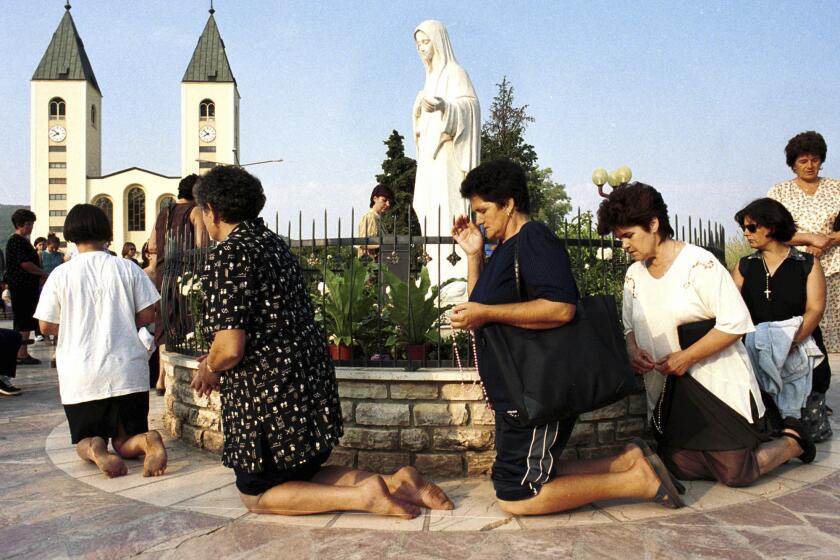Guns That Fire Only for Owner Targeted for Police
A criminal grabs a gun away from a police officer, points it and pulls the trigger.
Nothing happens.
That’s because it’s a “smart gun”--one that can be fired only by someone with the code.
That code could be a ring worn by the officer or a remote control that sends a signal to a receiver in the gun’s grip. It could even be a fingerprint.
Sgt. Bill Conroy, firearms training supervisor for the police department in Kansas City, Mo., said his No. 1 concern for such a gun is that it “works every time and does what it’s supposed to do--eliminate the threat” of the weapon’s being used against the officer.
And that’s what scientists at Sandia National Laboratories are trying to achieve.
The lab, a Department of Energy installation here best known for nuclear weapons research, received a $620,000 grant from the National Institute of Justice to develop a weapon that can be fired under all kinds of conditions--but only by people it recognizes.
The project manager, Sandia electrical engineer Douglas Weiss, likens a smart gun to a lock and key.
“A key is something unique you have, I don’t,” he said. “You apply the concept to firearms, (so) only authorized persons--the person with the key--can use the . . . gun.”
Although Sandia’s project is aimed at saving police officers’ lives, it also could keep children who get hold of guns from accidentally shooting themselves or someone else, Weiss said.
And, he said, perhaps technology could someday discourage criminals from stealing guns by making it too difficult for them to find a way to make the weapons work.
Although the idea for a smart gun has been around for years, Sandia’s involvement began 2 1/2 years ago when Department of Energy security officials began taking a fresh look at security ideas, including weapons that could be fired only by certain people.
Word got to the National Institute of Justice, which could see the possible benefits for law enforcement. The institute funds research for the Department of Justice.
About 16% of all officers killed in the United States in the line of duty over the last 15 years were shot with their own guns or those of their partners, Weiss said. Those statistics, he said, don’t include officers who were wounded or who might have been shot had they not successfully fought off an attempt to take their weapon.
Sandia began the project a year ago by asking police, from chiefs to officers on the street, what they require in a weapon.
That resulted in a profile of the ideal gun: one that will do everything, Weiss said.
Conroy’s Kansas City department was among those surveyed.
He said it’s important that the weapon still work if it’s been knocked around or that if he had to grab his partner’s gun, it would fire for him.
“It would take, for me personally, a lot of study and proof that it’s reliable. If it’s 99.9% reliable, that’s something worth talking over,” he said.
Sandia is investigating, evaluating and assigning priorities to about 14 existing technologies that could be adapted to a smart gun, ranking the strengths and weaknesses according to officers’ ideals.
There already are demonstration models, two built during the security study, and a third more recently.
The next step, Weiss said, will be to take working models to the officers and say: “When we talked before, this is what you told us, this is what we came up with from what you told us. Now see if it’s really what you had in mind.”
Then a prototype will be built. Weiss expects it will be ready by January.
Like Conroy, officers surveyed were most concerned over reliability.
“A police officer uses his gun as a last option. . . . When you get to that level, the gun has to work in any type of environment, any situation they may get into,” Weiss said.
“In Southern California, you may have an officer running down the beach, he’s wet from perspiration, he’s got sand all over him. Then you have an officer in Alaska, it’s cold, he’s shivering, he’s got gloves on. An officer in Florida may be walking through a swamp. And the same guns are used.”
Police also want a gun that would recognize more than one person, so an officer could use a downed partner’s weapon, Weiss said.
The gun also has to be simple--you don’t have time to enter a combination if someone’s shooting, Weiss said.
Finally, the cost of the weapon and training must be minimal, he said.
More to Read
Start your day right
Sign up for Essential California for news, features and recommendations from the L.A. Times and beyond in your inbox six days a week.
You may occasionally receive promotional content from the Los Angeles Times.






